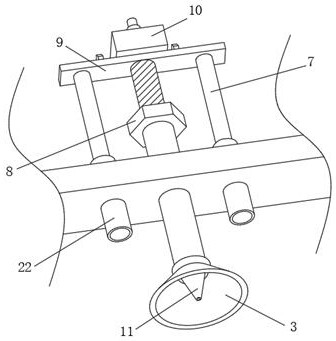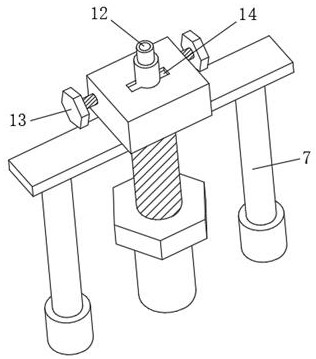Self-negative-pressure pericardium puncture device
A technique of pericardiocentesis and conceit, applied in the direction of puncture needle, trocar, etc., can solve the problems of puncture needle obstruction, heart injury, puncture pressing pressure is small and cannot penetrate the pericardial cavity, etc., to avoid poor grasp and reduce position deviation Effect
- Summary
- Abstract
- Description
- Claims
- Application Information
AI Technical Summary
Problems solved by technology
Method used
Image
Examples
Embodiment 1
[0035] When the present invention is in use, the patient is first laid flat on the operating bed, and the patient's top is taken off, and the accurate puncture position is drawn on the patient's chest to determine the subsequent surgical puncture position, and then the installation and fixation of the device is prepared. Rotate the second threaded ring 19 on both sides of the equipment board 1, so that the adjustment screw 18 moves outward from the two sides of the equipment board 1 to ensure that the equipment board 1 is directly above the position of the patient's chest cavity, and at the same time make the two sets of decks 5 It is located on both sides of the operating table, and then the fixing jacket 21 is fixedly clamped on the side edge of the operating table, and fixed and installed through the locking bolts on the side of the fixing jacket 21, and then the equipment board 1 is pressed down, and the device Plate 1 drives two groups of card holders 5 to slide downward o...
Embodiment 2
[0037] After completing Embodiment 1, the puncture needle 12 is inserted from the position of the draw-in groove 14 to the inside of the adjustment tube 4, and the bottom end of the puncture needle 12 passes through the hollow tube 2 and enters downward into the inside of the tapered tube 11, At this time, the clamping rod 15 on the top of the puncture needle 12 enters the inside of the clamping groove 14, and then the adjusting heads 137 on both sides of the fixing seat 10 are rotated to make the first threaded rod 131 and the second threaded rod 132 rotate synchronously. The cylinder 133 moves in the middle of the outer surface of the first threaded rod 131 and the second threaded rod 132 respectively, and is slidably connected directly above the chute through the slider 134 at the bottom. The two groups of clamping blocks 136 move to the middle, so that the two groups of clamping blocks 136 enter the inside of the clamping groove 14, and finally the two groups of clamping bl...
Embodiment 3
[0039] After completing Embodiment 2, the bottom end of the puncture needle 12 is now inside the conical tube 11, and the bottom end of the conical tube 11 is in contact with the patient's skin. The adjusting tube 4 moves to the inside of the hollow tube 2. At this time, the adjusting tube 4 drives the fixing seat 10 to move downward through the connecting plate 9, and the fixing seat 10 drives the puncture needle 12 to move downward slowly, and finally the bottom end of the puncture needle 12 is stabbed. Piercing the patient's skin, and inserting it into the patient's pericardial cavity from the designated operation position, during this process, the limit rods 7 on the lower surfaces of the two sides of the connecting plate 9 slide downward inside the limit sleeve 22, and the regulating tube The movement of 4 is limited to prevent the adjustment tube 4 from rotating with the first threaded ring 8. At this time, the doctor can observe the moving distance of the end of the punc...
PUM
 Login to View More
Login to View More Abstract
Description
Claims
Application Information
 Login to View More
Login to View More - R&D
- Intellectual Property
- Life Sciences
- Materials
- Tech Scout
- Unparalleled Data Quality
- Higher Quality Content
- 60% Fewer Hallucinations
Browse by: Latest US Patents, China's latest patents, Technical Efficacy Thesaurus, Application Domain, Technology Topic, Popular Technical Reports.
© 2025 PatSnap. All rights reserved.Legal|Privacy policy|Modern Slavery Act Transparency Statement|Sitemap|About US| Contact US: help@patsnap.com



